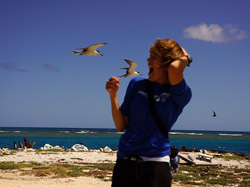Personal Reflection by Etta Karth – 2012 Maritime Heritage Expedition
I've always had a fascination with marine ecosystems, especially those that aren't easily accessible, wondering...what's down there? We know so much about the stars, yet more mysteries lie beneath the 70% of oceans that drape the planet.
I'm from landlocked Chicago. Sure, we have the Great Lakes, but I felt that the oceans are where things are really happening. The first time I visited one of them - the Pacific - was at age 17 in San Francisco, California. The second time was during my final year in high school. My AP Biology teacher, Mr. Donato, was one of the best teachers I've ever had. Even if you didn't like science, you would after meeting this guy. We took a two-week camping trip to Andros Island in the Bahamas that changed my life. This was the reason I made my way to Hawaiʻi: warm weather, incredible marine ecosystems and a one-of-a-kind culture.
As a new student at the University of Hawaiʻi at Hilo on the Big Island, I was lucky to have a guest speaker – Jeff Kuwabara, the first manager for Mokupāpapa Discovery Center for Hawaiʻi's Remote Coral Reef Ecosystems (the interpretative center for the Northwestern Hawaiian Islands [NWHI] in Hilo) – present at one of my classes. I, like many, was unaware of the gems that are the Northwestern Hawaiian Islands. I became a volunteer at the center to help share this secret with anyone who would listen.
I interned at Mokupāpapa Discovery Center three times, and was nominated volunteer of the year in 2008. Then, a year and a half ago, I got a full-time job there – a dream come true! This summer, after eight years of working to interpret the Northwestern Hawaiian Islands, I was asked to participate in the Maritime Heritage cruise about the NOAA ship Hiʻialakai. Now, I'm actually here in Papahānaumokuākea Marine National Monument and World Heritage Site, one of the largest Marine Protected Areas on the planet. I've seen more shades of blue than I knew existed, clouds the color of green and pink, and wildlife so abundant that you have to get out of the way.
Not many people get a chance to experience such uniqueness, let alone represent it. That is why the work that the scientists do each cruise season is so important. Every day they are out here, they are gaining valuable knowledge to share with the rest of the world. Evidence of long-lost ships that plied these waters for their marine bounty, information about the movements of sharks and other predators throughout the Hawaiian archipelago, data on coral bleaching and alien species – all of which can contribute to better management of our resources back home.
Each moment spent with the scientists, boat crew and incredible ocean wilderness has been a life-changing experience, the lessons from which I will bring back to share with the world through my job of educating people about this remarkable place.

